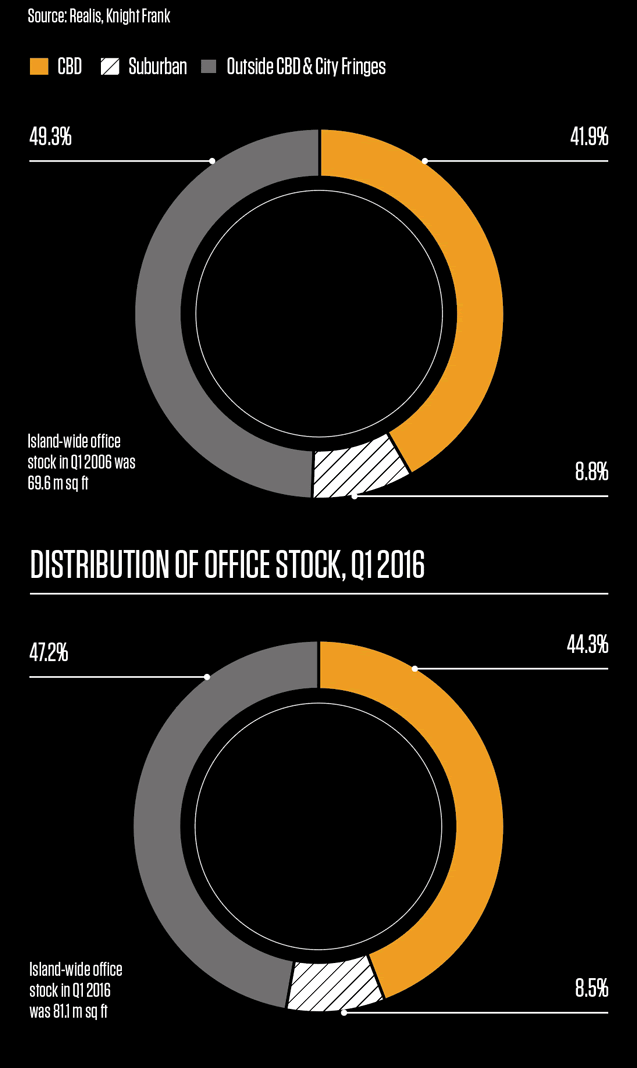SINGAPORE
DECENTRALISATION OR RECENTRALISATION?
The push for decentralisation could accelerate as Singapore expands new business precincts and the public transport network
As Singapore continues to advance its built environment to augment itself as a global and regional centre of finance, communications, trade and commerce, the office landscape has been growing appreciably. Since the introduction of decentralisation strategy that was firstly mooted in the 1991 Concept Plan, a series of hierarchical commercial centres were planned, i.e. regional centres, sub-regional fringe centres and smaller precincts. While office space stock in the Central Business District (CBD, i.e. Downtown Core) grew by 23.4% for the past ten years to reach around 36 million sq ft in Q1 2016, the outside-CBD and city fringe areas saw a growth of 11.6% to touch 38 million sq ft; the Outside Central Region (i.e. suburban areas) expanded by 12.5% to reach close to seven million sq ft over the same period.
DISTRIBUTION OF OFFICE STOCK, Q1 2006
The Urban Redevelopment Authority has rolled out some significant city fringe and suburban precincts to push ahead with the decentralisation strategy. Suburban regional centres such as Tampines and Changi are now the backroom hubs for various financial institutions, as they sought cheaper office occupation costs in business park and office spaces. The next emerging city fringe precinct that is rising in popularity is one-north, occupying a total of 185 hectares of land area and housing an increasing number of companies from biosciences, research & development institutes, multinational corporations such as Volvo and Shell, and now from the TMT sector (i.e Telecommunications, Media and Technology).
Despite the flight to lower-cost office space in the city fringes and suburban areas in the last couple of years, the falling office rental trends in Singapore, especially for prime grade office buildings located in the CBD, is attracting companies back to the CBD. With the global finance business undergoing a consolidation phase with various financial institutions giving up some of their office space and coupled with lower demand from many enterprises, office rents of prime grade A and A+ spaces in the CBD has declined by 11.9% for the past five quarters from its previous peak in Q1 2015. Following this trend, the ‘flight-to-quality and back to the city centre’ phenomenon is gathering pace.
In addition to taking advantage of lower rents in the CBD, more companies are seeking prime locations in the city centre with better quality office specifications, enabling them to create more conducive office interiors. Concepts such as the agile activity-based working are gaining in popularity in Singapore, as part of companies’ recruitment and retention strategies for aspiring young professionals.
“CONCEPTS SUCH AS THE AGILE ACTIVITY-BASED WORKING ARE GAINING IN POPULARITY IN SINGAPORE, AS PART OF COMPANIES’ RECRUITMENT AND RETENTION STRATEGIES FOR ASPIRING YOUNG PROFESSIONALS”
THE CBD REMAINS THE HUB
The growing scale and vibrancy of the CBD have proved to be strong magnets to attract a wider occupier base, ranging from finance and insurance, trading and professional services,
to even co-working spaces, working and learning in close proximity and harnessing a pulsating business ecosystem. This would be difficult to replicate in city fringe and suburban precincts in the near term. Based on Knight Frank Office Advisory team’s observations, the proportion of office tenants looking to renew, relocate or set up new office in the CBD remains high at around 70% since mid-2015.
GOVERNMENT’S NEXT DECENTRALISED LOCATIONS
Singapore’s commercial real estate stock will need to expand to support its long-term objectives of creating a diversified and sustainable economy, targeting areas such as health care, education, logistics, aerospace, petrochemicals, and biotechnology. Additionally, Singapore’s plans to build a Smart Nation, through the Smart Nation iN2015 masterplan, will support the evolution of future workplaces that could weave commercial and industrial spaces in new formats that might be better created in new precincts beyond the city centre.
Since the award of the land tender at Paya Lebar Central in east city fringe of Singapore, the government’s plans to develop Woodlands North Coast, Jurong East Regional Centre and Jurong Innovation District are underway. The office stock in the suburban areas is likely to grow at a higher rate in the next ten to 15 years.
